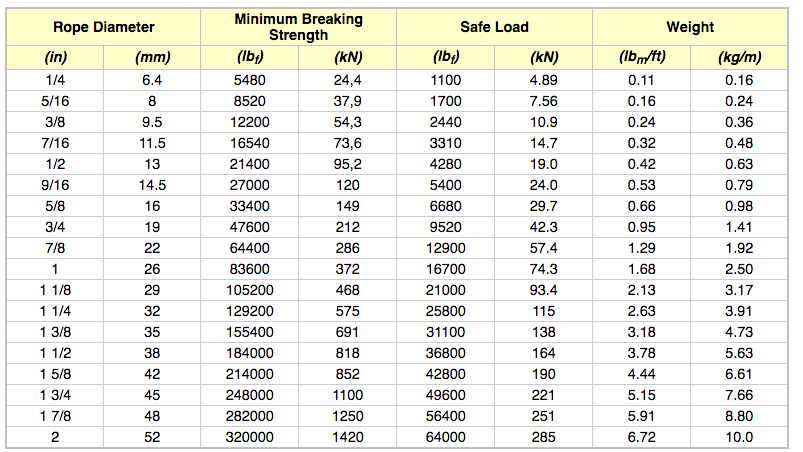While wire rope is a relatively simple piece of equipment, there are several terms and factors that you must be aware of before you, or any of your staff, operate this gear. Below you will find a handy all-in-one wire rope weight guide.
Limits that apply to all lifting gear
One of the most important pieces of information, and this applies to any piece of lifting gear that lifts loads, are the
safe working load and minimum breaking limit. These are two separate limits, but both apply to the same piece.
 It’s important not to exceed the wire rope weight limit
It’s important not to exceed the wire rope weight limit
The
safe working load (SWL), also referred to as the working load limit (WLL) or the normal working load (NWL), is the figure that you should be operating at whenever using it. It will change depending on the strength of your rope, and is the figure that the manufacturer has deemed safe to work at. You may also see this being referred to as simply the safe load.
On the other hand, the minimum breaking limit (MBL) refers to the absolute maximum a piece of equipment can be operated at before it breaks. This will have been tested by your manufacturer, and is a figure well above that of the SWL.
Take note of all advice offered to you by your manufacturer, as this will help to prolong the service life of your equipment.
Breaking limits
To help demonstrate the breaking limit of wire rope, The Engineering Toolbox have put
together this handy table. It lists the strength of improved plow steel (IPS) wire rope that is uncoated and has a fibre core.

They have also offered an example of the strength of 3/8” wire rope that has a safe working load of 10.9 kN. To determine the strength, the calculation m = F / g is used, where:
- m = mass in kilograms
- F = force (weight) in newtons
- g = acceleration of gravity (9.21 m/s2)
Using this equation for the 3/8” wire rope, you would calculate the strength as:
m = (10.9 10
3 N) / (9.81 m/s
2), which equals 1111 kg.
If maths isn’t particularly your strong suit, then fret not! The above information isn’t imperative to know, but is a useful reference point should you like to know how strength is calculated.
These calculations will have been worked out by your clever manufacturers beforehand using this equation. So, whatever safe working load is provided to you, it’s absolutely crucial that you stick to it. It isn’t just a random figure!
How can you help to protect your wire rope?
To ensure that all of the guidelines and limits are followed, it’s essential that you
train your staff properly. Having the right awareness with a piece of equipment is actually part of the law, as it requires competent people to be planning and operating all lifting equipment.
This training must include proper training with how to use the equipment, sufficient knowledge of weight limits, and what signs of damage to look out for in gear. Should you, or any of your staff, exceed the SWL or notice any damages at any time, please contact one of us immediately.
Other information to be aware of
Alongside these wire rope weight guides, it’s also important that you familiarise yourself with the relevant laws too. We have detailed all
ISO standards that relate to wire rope here, and you can read more on the
Lifting Operations and Lifting Equipment Regulations 1998 (LOLER) here.
If you would like to discuss anything that you’ve read above about the wire rope weight guides in more detail, then please feel free to contact us
here.
 It’s important not to exceed the wire rope weight limit
The safe working load (SWL), also referred to as the working load limit (WLL) or the normal working load (NWL), is the figure that you should be operating at whenever using it. It will change depending on the strength of your rope, and is the figure that the manufacturer has deemed safe to work at. You may also see this being referred to as simply the safe load.
On the other hand, the minimum breaking limit (MBL) refers to the absolute maximum a piece of equipment can be operated at before it breaks. This will have been tested by your manufacturer, and is a figure well above that of the SWL.
Take note of all advice offered to you by your manufacturer, as this will help to prolong the service life of your equipment.
It’s important not to exceed the wire rope weight limit
The safe working load (SWL), also referred to as the working load limit (WLL) or the normal working load (NWL), is the figure that you should be operating at whenever using it. It will change depending on the strength of your rope, and is the figure that the manufacturer has deemed safe to work at. You may also see this being referred to as simply the safe load.
On the other hand, the minimum breaking limit (MBL) refers to the absolute maximum a piece of equipment can be operated at before it breaks. This will have been tested by your manufacturer, and is a figure well above that of the SWL.
Take note of all advice offered to you by your manufacturer, as this will help to prolong the service life of your equipment.
 They have also offered an example of the strength of 3/8” wire rope that has a safe working load of 10.9 kN. To determine the strength, the calculation m = F / g is used, where:
They have also offered an example of the strength of 3/8” wire rope that has a safe working load of 10.9 kN. To determine the strength, the calculation m = F / g is used, where: